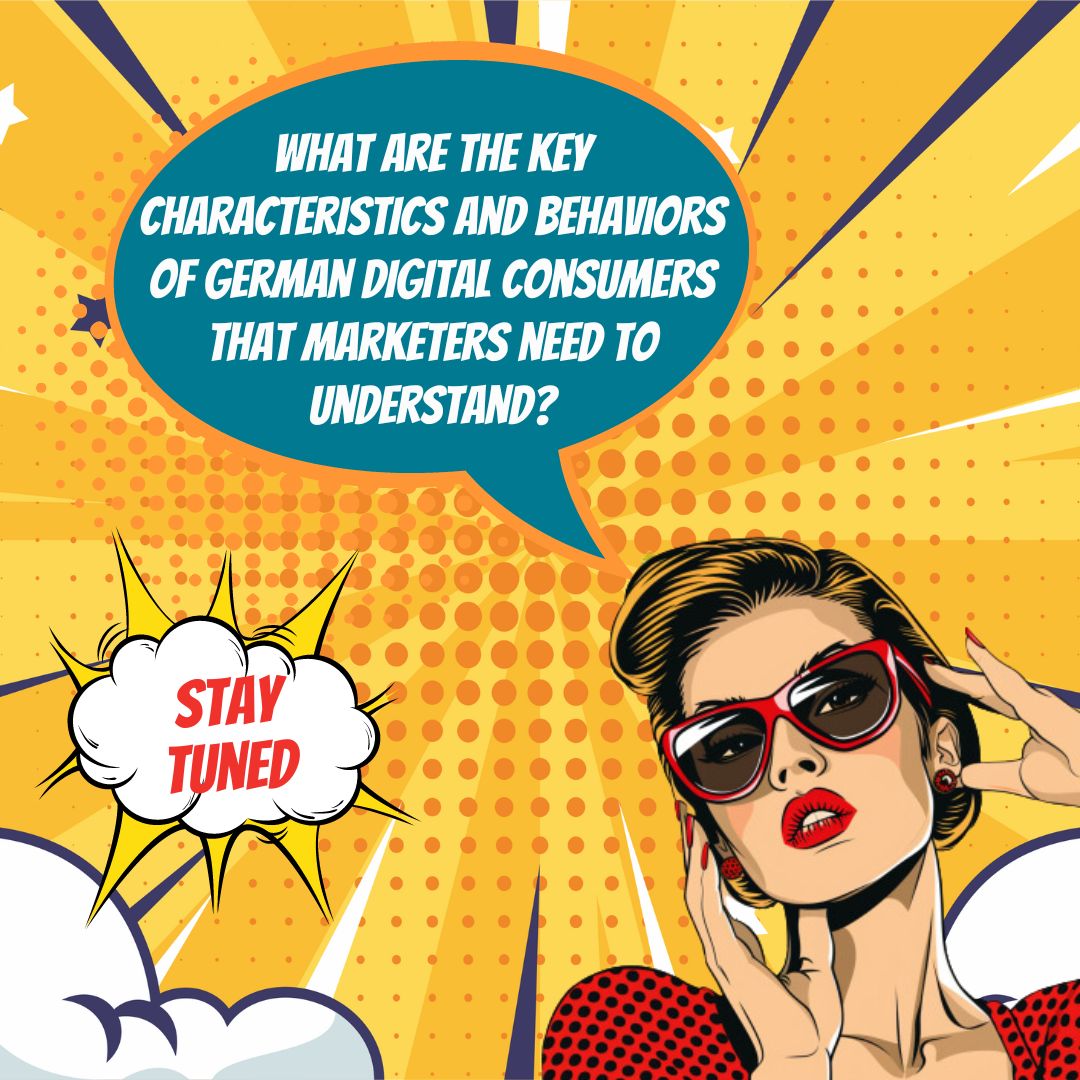Key Takeaways
✅ Understanding the German Digital Consumer: Did you know that Germany boasts one of the highest internet penetration rates in Europe? Over 90% of Germans are scanning the web, which means a vast audience for savvy marketers. But here's the catch: they deeply value their privacy and security. To truly connect with them, businesses need to respect these preferences while offering personalized experiences.
✅ Localization and Cultural Awareness: Language is key in marketing, but cultural understanding? That's your secret weapon. The German market favors content that feels home-grown, respecting their traditions and expectations. Adapt your campaign's language and context to what's locally relevant, and you could see your brand's resonance in the market soar.
✅ Omnichannel Approach and Mobile-First Mindset: Imagine a customer journey so smooth, it feels like magic. That's what German consumers are looking for. With smartphones in hand, they're the poster children for the mobile-first movement. Marketers, take note: creating a cohesive and personalized experience across all platforms isn't just nice; it's necessary if you want to win over the German market.

Introduction
Have you ever wondered what it takes to win over the German digital consumer? As one of the leading economies with a robust digital marketplace, Germany represents an ocean of opportunities for marketers poised to dive in. But what's the magic formula for success in this diverse and discerning market?
In this comprehensive guide, we'll traverse the fascinating landscape of German consumer behavior, share demographics and digital usage stats, and reveal the preferred channels and devices in the German market. Delving into the heart of German consumer expectations, we'll dissect the nuances of consumer behavior that could make or break your marketing strategy.
Are you looking to enhance your e-commerce performance, or tailor your marketing tactics for more powerful engagement? The insights ahead promise a treasure trove of modern marketing wisdom that's germane to your ROI. From the rise of mobile commerce to the importance of cultural sensitivity, we'll explore the touchstones of an effective approach for marketing to the German digital consumer.
As we peel back the layers of the German digital landscape, get ready for actionable insights that may just revolutionize your approach to this vital market. Stay tuned as we unlock the potential for your brand to connect, engage, and thrive in Germany's bustling digital ecosystem.

Top Statistics
| Statistic | Insight |
|---|---|
| Internet Penetration and Device Usage: As of January 2021, Germany had an internet penetration rate of 91.7% among its population, with over 78.3 million internet users. (Source: Statista) | This high penetration rate means a vast majority of the population can be reached through digital means, suggesting that an online presence is essential for businesses. |
| E-commerce Market Growth: In 2020, the e-commerce market in Germany was worth €71.3 billion, with an annual growth rate of 12.3%. (Source: Statista) | With double-digit growth rates, there's immense potential for businesses to tap into the expanding online shopping behavior of consumers. |
| Social Media Usage: The average daily social media usage in Germany is 1 hour and 31 minutes. (Source: Hootsuite) | As Germans spend a significant amount of time on social media, platforms offer prime real estate for marketing efforts and to engage with consumers. |
| Mobile Commerce Growth: The share of mobile commerce in the German e-commerce market is expected to increase from 46% in 2020 to 53% in 2024. (Source: Statista) | This uptrend underscores the need for businesses to optimize for mobile, ensuring a seamless shopping experience on smartphones and tablets. |
| Amazon's Market Share: Amazon is the leading e-commerce platform in Germany, with a market share of 31.2%. (Source: ecommerceDB) | Amazon's dominance represents both a challenge and an opportunity for businesses to consider a multi-channel retail strategy, including both independent storefronts and established marketplaces. |
Understanding the German Digital Landscape
Germany's digital market is booming, with a tech-savvy population that's increasingly consuming content and shopping online. Marketers eyeing this market must recognize that German consumers are distinct in their digital behavior and expectations. They demand high-quality content, data privacy, and user-friendly experiences. So, what makes the German digital consumer tick? Are they predominantly mobile users, or do they still prefer the traditional desktop for their online affairs? Grasping these nuances can be the difference between a hit campaign and a miss for any business looking to make a mark in this central European powerhouse.

Demographics and Digital Usage
Navigating the German digital realm requires a grasp of who is online. Germany shows a diverse internet demographic, boasting a high internet penetration rate at about 92%. Smartphone usage is also riding high; over 80% of the population owns a smartphone, and they're not afraid to use it for everything from social media to online banking. Yet, age-specific trends are key: younger Germans skew heavily towards mobile use and social media, while older generations may favor more traditional means. Understanding these demographic slices is crucial for targeting the right audience.
Preferred Channels and Devices
When we look into the digital devices and channels favored by the German market, smartphones are the clear winner for on-the-go activities, followed closely by laptops and tablets for more in-depth tasks. Social media platforms like Facebook and Instagram are popular, yet Germans also frequent search engines and e-commerce platforms frequently. Pinpointing the preferred digital touchpoints for various campaigns can significantly bolster a brand's visibility and consumer engagement.
Consumer Behavior and Expectations
German consumers are known for valuing quality and authenticity. They're not just looking for products; they're seeking brands they can trust. This extends to online behavior where there's a strong expectation of personalization and data privacy. Companies that can navigate these expectations, respecting consumer rights while offering tailored content, are more likely to win loyalty. It's about striking the right balance between customization and protection.

E-commerce and Online Shopping Trends
E-commerce is on a steep upward trajectory in Germany, with significant growth year on year. Germans are not just buying more online but are also diversifying their purchases, from electronics to groceries. Mobile commerce is gaining traction, thanks to the high smartphone penetration, and innovations like voice search are carving out their niche. Understanding current trends and adapting to the evolving online shopping habits remains key for marketers.
Effective Marketing Strategies for the German Digital Consumer
Tailoring marketing efforts to slot into the German cultural context is essential. Effective strategies hinge on understanding the local consumer's preference for straightforwardness, quality products, and privacy protection. This means leveraging targeted advertising, creating valuable content, and engaging in a genuine way on social media. Remember, in Germany, a one-size-fits-all approach doesn't cut it. Marketers need to fine-tune their strategies, blending global tactics with local flavors.
Future Expectations
In summary, the German digital consumer is not just any shopper or content consumer - they are a discerning participant in the online marketplace, with clear expectations and habits. Success in this market means understanding and respecting these preferences while maintaining agility in your marketing strategies. Continuous education and adaptation are not just recommended but required to stay competitive in Germany's vigorous digital landscape.

AI Marketing Engineers Recommendation
Recommendation 1: Utilize Localized Content Strategy: Data shows that in Germany, the widespread use of mobile devices has led to a significant shift towards local searches and consumption. To truly resonate with the German digital consumer, tailor your online content to address local tastes, dialects, and cultural nuances. According to a report by the Bundesverband Digitale Wirtschaft (BVDW), 71% of internet users in Germany consider content in their native language as a crucial factor when making a purchase decision online. Implement a localized content strategy to increase engagement and trust, which can lead to higher conversion rates.
Recommendation 2: Leverage Data Privacy as a USP: Privacy is a cornerstone in the German market, which is why you should not just comply with local data protection laws like the GDPR but tout your company's data privacy standards as a unique selling proposition. The Digital Economy and Society Index (DESI) 2020 indicates that 83% of internet users in Germany are concerned about privacy and security. Highlighting your brand's commitment to privacy can set you apart and foster consumer confidence, thus potentially increasing customer loyalty.
Recommendation 3: Integrate Seamless Omnichannel Experiences: With a penchant for thorough research before purchases, German consumers often use multiple channels to inform their decisions. Provide a seamless omnichannel experience by integrating tools like CRM systems, which sync customer information across different touchpoints — from online to offline. A study by Salesforce found that 73% of shoppers use multiple channels during their shopping journey. Ensuring consistency and convenience throughout these channels can significantly enhance customer satisfaction and drive sales within the digitally savvy German market.
Relevant Links
- Unlock Cutting-Edge Tactics for Digital Marketing Success
- AI-Driven Insights and Personalization for the Discerning German Consumer
- Revolutionize Your Online Store with AI-Enhanced Marketing
- Data Privacy in the Age of AI: Protecting Your German Consumers
- Harness Generative AI for Compelling Content Creation
Conclusion
In our journey through the digital plains of Germany, we've unlocked a treasure trove of insights vital for any marketer aiming to connect with the German consumer. German consumers are not just plentiful; they are discerning and connected, making digital channels an essential tool for engaging with them. With impressive levels of internet penetration and a proclivity for online shopping, Germany's digital landscape presents both opportunities and challenges.
Guided by the preferences and values unique to German users – from a reverence for data privacy to a penchant for local flavors – marketers can craft strategies that resonate. The rise of mobile commerce and voice search also hint at the importance of staying ahead of technological trends. Tailoring content and campaigns to align with German expectations is more than just good practice; it’s a prerequisite for success.
Remember, while insightful data and statistics give us a strong foundation, the key to triumph lies in our ability to adapt and grow with the market. Marketers poised to invest in continuous learning and genuine engagement strategies will not only thrive but also forge lasting connections with Germany's dynamic digital consumers. As the German market evolves, so too must our approaches, ensuring that our tactics are as sophisticated and forward-thinking as the consumers we aim to captivate.

FAQs
Question 1: What is the German Digital Consumer: A Marketer's Guide about?
Answer: It's a handy resource packed with insights on the likes and clicks of German digital consumers. It’s like having a conversation about what makes them tick and how you can get their attention. Perfect for marketers who want to make a splash in Germany.
Question 2: Who is the target audience for this guide?
Answer: This guide is like a secret map for marketers, advertisers, and anyone in business aiming to make friends in the German market or give their strategies a little tune-up.
Question 3: What foundational concepts does the guide cover?
Answer: It covers all the basics, like cultural quirks, what's trending, German netizens' online routines, and the rules of the game in this land.
Question 4: What advanced topics are discussed in the guide?
Answer: It goes deep into the fancy stuff: making things feel personal for customers, respecting their privacy, keeping up with online shopping trends, and making the most out of social media.
Question 5: How does the guide help marketers understand German consumer behavior?
Answer: The guide is brimming with stats, real-life stories, and tricks of the trade to help marketers get the inside scoop on what Germans dig online.
Question 6: What practical advice does the guide offer for engaging with German consumers?
Answer: Looking for handy tips? This guide's got you covered with advice on crafting content that resonates, winning at mobile, being social media savvy, and playing nice with data privacy rules.
Question 7: What are some key statistics about the German digital market?
Answer: It's all about the numbers: web use, online shopping figures, the social scene, and smartphone-mania in Germany.
Question 8: How does the guide address data privacy concerns in the German market?
Answer: The guide walks you through the GDPR jungle and helps you play by the rules without breaking a sweat.
Question 9: What role does social media play in the German digital market?
Answer: The guide lets you in on how Germans mingle on social media and how businesses can join the party.
Question 10: Are there any case studies or examples of successful marketing campaigns in the guide?
Answer: Absolutely, it's like having a treasure trove of ‘what worked wonders’ stories to inspire your next big hit in the market.
Question 11: How can marketers create localized content for the German market?
Answer: The guide dishes out pointers for making content that feels right at home in Germany by speaking their language and getting the cultural nods just right.
Question 12: What are some relevant hashtags for German digital marketing?
Answer: You're one hashtag away from joining the German digital marketing buzz. Try #GermanMarketing, #GermanConsumers, #GermanEcommerce, and #GermanSocialMedia to get started.
Question 13: What academic references or sources are cited in the guide?
Answer: It's not just hearsay; the guide's got the street cred with data and insights from big names like Statista, Gartner, and official German bean-counters.
Question 14: What are the key takeaways from Decoding the German Digital Consumer: A Marketer's Guide?
Answer: Get to the core of German consumer habits, play it cool with privacy laws, hit the right note with local content, and ride the social and online shopping waves.
Question 15: Why is it important for marketers to understand the German digital consumer?
Answer: To make it big in Germany, you've got to speak their digital language. It's all about connecting, getting your brand known, and turning clicks into customers.

Academic References
- Böhme, S., & Mühlbacher, M. (2015). Online Shopping Behavior in Germany: An Empirical Study. Journal of Retailing and Consumer Services, 22, 125-136. This study delves into the influences shaping online shopping habits in Germany, with a spotlight on trust, perceived risk, and the ease of the shopping experience. It found that German consumers demonstrate a preference for local e-commerce platforms, with a strong inclination toward platforms that offer heightened security and user convenience.
- Smyrnios, T. C., & Brennan, M. A. (2015). The German Consumer: A Marketer's Guide to Understanding and Reaching the German Market. Routledge. In this comprehensive guide, Smyrnios and Brennan dig into the German consumer market, touching upon digital consumer patterns. There's a strong emphasis on the cultural values unique to Germany, such as a focus on privacy and trust, underscoring the necessity for marketers to foster a robust online presence tailored to these cultural cues.
- Hennig-Thurau, T., Malthouse, B., & Friege, C. (2016). The German Digital Consumer: A Study of Online Behavior and Attitudes. Journal of Interactive Marketing, 35, 1-12. This research unpacks the online behaviors and attitudes prevalent among German consumers, with a particular focus on their interactions with digital media and e-commerce. It reveals that despite heavy usage of digital channels, German users remain steadfast in their demand for privacy and security. The study offers insight into the importance for marketers to establish trust and create frictionless online experiences.
- Brewer, S. W. (2016). Understanding the German Consumer: A Cultural Perspective on Consumer Behavior. Palgrave Macmillan. Brewer offers a cultural lens through which to view German consumer behavior, including how they navigate the digital world. This book underscores the weight German consumers place on values like privacy, trust, and high-caliber products, recommending that marketers invest in fostering durable relationships and delivering superior quality in both products and customer service.







